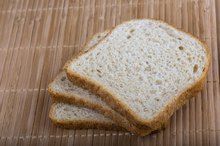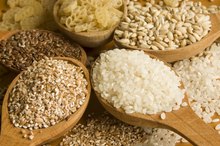What does fact checked mean?
At Healthfully, we strive to deliver objective content that is accurate and up-to-date. Our team periodically reviews articles in order to ensure content quality. The sources cited below consist of evidence from peer-reviewed journals, prominent medical organizations, academic associations, and government data.
- Harvard School of Public Health: Carbohydrates
- Centers for Disease Control and Prevention: Nutrition for Everyone: Basics: Carbohydrates; Feb 23, 2011
The information contained on this site is for informational purposes only, and should not be used as a substitute for the advice of a professional health care provider. Please check with the appropriate physician regarding health questions and concerns. Although we strive to deliver accurate and up-to-date information, no guarantee to that effect is made.
What Is a Serving of Carbohydrates?
Carbohydrates are vital for health and serve a variety of important functions for the body 1. They are naturally found in a variety of foods such as fruits, vegetables, dairy, nuts and grains. In addition, carbohydrates may also be added to various processed foods as sugar. Consult a registered dietitian for a full list of nutrient-dense carbohydrates.
Carbohydrate Servings
A typical carbohydrate serving size is approximately 15 grams. The grams refers to the amount of carbohydrates in the serving, not the actual weight of the food. Common examples of a carbohydrate serving include 1 slice of bread, 1 bagel, one-half cup of cooked pasta, 1 cup of raw vegetables or 1 apple. Servings of liquids include 1 cup of skim milk, one-half cup of fruit juice or 12 ounces of beer.
- A typical carbohydrate serving size is approximately 15 grams.
- Common examples of a carbohydrate serving include 1 slice of bread, 1 bagel, one-half cup of cooked pasta, 1 cup of raw vegetables or 1 apple.
Carbohydrate Functions
Carbohydrate Allergy
Learn More
Carbohydrates serve vital functions in energy production and disease prevention. In the body, carbohydrates are broken down into sugars where they are immediately used for energy or stored for later use. The three main types of carbohydrates found in foods include sugars, starch and dietary fiber. Sugar is a carbohydrate in its simplest form and is found naturally in fruits, vegetables and dairy products. Complex carbohydrates such as starch and fiber can be found in many vegetables, grains, legumes and seeds. Carbohydrates that provide fiber may reduce your risk of many diseases such as diabetes and cardiovascular disease. In addition, dietary fiber also promotes fullness and supports digestive health.
- Carbohydrates serve vital functions in energy production and disease prevention.
- Complex carbohydrates such as starch and fiber can be found in many vegetables, grains, legumes and seeds.
Daily Recommendations
Carbohydrates should make up about 45 to 65 percent of your total calories. For example, if you require 2,000 calories daily, consume roughly 900 to 1,300 calories from carbohydrates. Depending on your exact requirements, that translates to about 60 to 75 grams or four to five servings of carbohydrates with every meal. Specific requirements vary depending on energy needs, gender and activity level. Consult with a registered dietitian for your exact carbohydrate and daily calorie requirements.
- Carbohydrates should make up about 45 to 65 percent of your total calories.
- Consult with a registered dietitian for your exact carbohydrate and daily calorie requirements.
Carbohydrate Choices
Four Functions of Carbohydrates in Our Bodies
Learn More
The Harvard School of Public Health notes the best carbohydrate sources include nutrient-dense foods such as whole grains, vegetables, fruits and legumes 1. These foods are abundant in essential vitamins, minerals and dietary fiber. Common examples of whole grains include:
- brown rice
- bulgur
- quinoa
- buckwheat
- barley
- oats
- whole wheat
- rye
Focus on fresh or frozen fruits and vegetables that do not have any added sugars. When choosing dairy products, stick to skim or low-fat options that provide many nutrients but fewer calories from saturated fat.
- The Harvard School of Public Health notes the best carbohydrate sources include nutrient-dense foods such as whole grains, vegetables, fruits and legumes 1.
Related Articles
References
- Harvard School of Public Health: Carbohydrates
- Cleveland Clinic. Glycogen storage disease (GSD). Updated August 2, 2019.
- Poti JM, Braga B, Qin B. Ultra-processed food intake and obesity: What really matters for health-processing or nutrient content?. Curr Obes Rep. 2017;6(4):420-431. doi:10.1007/s13679-017-0285-4
- Winwood-Smith HS, Franklin CE, White CR. Low-carbohydrate diet induces metabolic depression: A possible mechanism to conserve glycogen. Am J Physiol Regul Integr Comp Physiol. 2017;313(4):R347-R356. doi:10.1152/ajpregu.00067.2017
- Hervik AK, Svihus B. The role of fiber in energy balance. J Nutr Metab. 2019;2019:4983657. doi:10.1155/2019/4983657
- Kunzmann AT, Coleman HG, Huang WY, Kitahara CM, Cantwell MM, Berndt SI. Dietary fiber intake and risk of colorectal cancer and incident and recurrent adenoma in the prostate, lung, colorectal, and ovarian cancer screening trial. Am J Clin Nutr. 2015;102(4):881-90. doi:10.3945/ajcn.115.113282
- Slavin J, Carlson J. Carbohydrates. Adv Nutr. 2014;5(6):760-1. doi:10.3945/an.114.006163
- Reynolds A, Mann J, Cummings J, Winter N, Mete E, Te Morenga L. Carbohydrate quality and human health: A series of systematic reviews and meta-analyses. Lancet. 2019;393(10170):434-445. doi:10.1016/S0140-6736(18)31809-9
Writer Bio
Anthony Isaac Palacios has been a professional writer for more than five years for various media including magazine, newspaper and the Internet. He has a Master of Science in dietetics and nutrition and specializes in health and nutrition articles for the general public. Palacios enjoys cooking with wine, and sometimes even adding it to the food.









